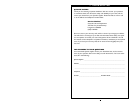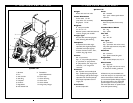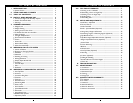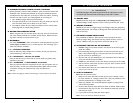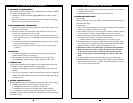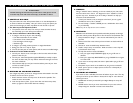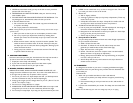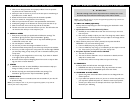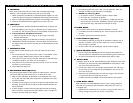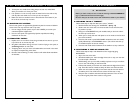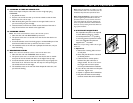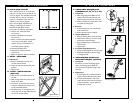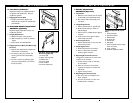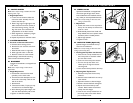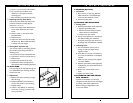
16 17
VII. WARNINGS: FALLS & TIP-OVERS
3. Make sure to keep pneumatic tires properly inflated. Low tire pressure
may allow the rear wheel locks to slip.
4. Move your chair as close as as you can to the seat you are transferring to.
If possible, use a transfer board.
5. Rotate the front casters until they are as far forward as possible.
6. If you can, remove or swing footrests out of the way.
a. Make sure your feet do not catch in the space between the footrests.
b. Avoid putting weight on the footrests as this may cause the chair to tip.
7. Make sure armrests are out of the way and do not interfere.
8. Transfer as far back onto the seat surface as you can. This will reduce the
risk that the chair will tip or move away from you.
I. CURBS & STEPS
1. Each person who helps you should read and follow the warnings "For
Attendants" (p. 11), and the "Tips For Attendants" (p. 21).
2. Do not try to climb or descend a curb or step alone UNLESS you are
a skilled rider of this chair and:
a. You can safely do a "wheelie"; and
b. You are sure you have the strength and balance to do so.
3. Unlock and rotate anti-tip tubes up, out of the way, so they do not interfere.
4. Do not try to climb a high curb or step (more than 4 inches high) UNLESS
you have help. Doing so may cause your chair to exceed its balance point
and tip over.
5. Go straight up and straight down a curb or step. If you climb or descend
at an angle, a fall or tip-over is likely.
6. Be aware that the impact of dropping down from a curb or step can dam-
age your chair or loosen fasteners.
J. STAIRS
1. NEVER use this chair on stairs UNLESS you have someone to help you.
Doing so is likely to cause a fall or tip-over.
2. Persons who help you should read and follow the warnings "For
Attendants" (p. 11), and the "Tips For Attendants" (p. 21).
K. ESCALATORS
NEVER use this chair on an escalator, even with an attendant. If you do, a fall
or tip-over is likely.
Note: If you modify this chair or use parts not approved by Quickie, it may void the
warranty and create a safety hazard.
▲
!
VIII. WARNINGS: COMPONENTS & OPTIONS
A. ANTI-TIP TUBES (Optional)
Anti-tip tubes can help keep your chair from tipping over backward in most
normal conditions.
1. Quickie Recommends Use Of Anti-Tip Tubes:
a. UNLESS you are a skilled rider of this chair and are sure you are not at
risk to tip over.
b. Each time you modify or adjust your chair. The change may make it easier
to tip backward. Use anti-tip tubes until you adapt to the change, and are
sure you are not at risk to tip over.
2. When locked in place (in the "down" position) anti-tip tubes should be
BETWEEN 1 1/2 to 2 inches off the ground.
a. If set too HIGH, they may not prevent a tip-over.
b. If set too LOW, they may "hang up" on obstacles you can expect in normal
use. If this occurs, you may fall or your chair may tip over.
3. Keep Anti-Tip Tubes Locked In Place UNLESS:
a. You have an attendant; or
b. You have to climb or descend a curb, or overcome an obstacle, and can
safely do so without them.
At these times, make sure anti-tip tubes are up, out of the way.
B. ARMRESTS
Armrests detach and will not bear the weight of this chair.
1. NEVER lift this chair by its armrests. They may come loose or break.
2. Lift this chair only by non-detachable parts of the main frame.
C. CUSHIONS & SLING SEATS
1. Quickie sling seats and standard foam cushions are not designed for the
relief of pressure.
2. If you suffer from pressure sores, or if you are at risk that they will occur,
you may need a special seat system or a device to control your posture.
• Consult your doctor, nurse or therapist to find out if you need such a
device for your well-being.
▲
!
Heed all warnings in this section. If you fail to do so a fall, tip-over or loss
of control may occur and cause severe injury to the rider or others.
▲
!
WARNINGS
Note: If you modify this chair or use parts not approved by Quickie, it may void the war-
ranty and create a safety hazard.




